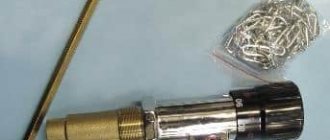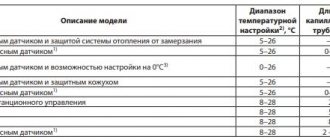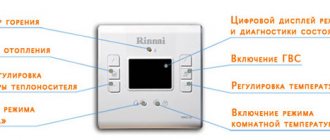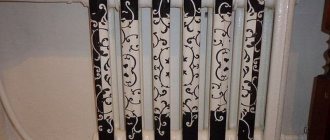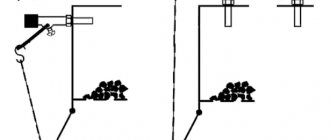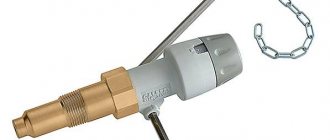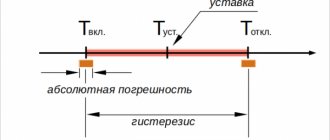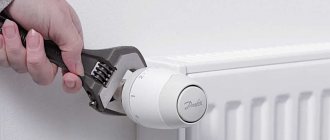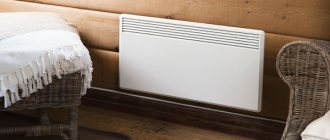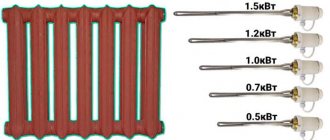Danfoss thermostats can be installed independently, but for this you need to know the direction of movement of the coolant (you can find out from the operating company) and what type of heating system you have, or rather single-pipe or two-pipe; this information can also be obtained from the operating company.
Sometimes it becomes necessary to adjust the temperature in each specific room. This can be done by installing a thermostat for the heating radiator. This is a small device that regulates the heat transfer of a heating battery. Can be used with all types of radiators, except cast iron. One important point is that the device can lower the initial temperature, but if there is not enough heating power, it cannot increase it.
Design of thermostats for heating radiators
The thermostat for a heating radiator consists of two parts - a valve (thermovalve) and a thermostatic head (thermostatic element, temperature regulator). These products are produced for different pipe sizes and different types of heating systems. The thermostatic head is removable; regulators of different types and even from different manufacturers can be installed on the same valve - the seat is standardized.
The thermostat for a heating radiator consists of two parts - a special valve (valve) and a thermostatic head (regulator)
There are different valves and regulators, so before installing a thermostat for a heating radiator, you will have to become at least a little familiar with its structure, functions and types.
Common Mistakes
Correct installation requires attentiveness from the master at every stage of work in order to avoid mistakes. The most common problem is the vertical position of the head. This leads to the fact that the room stops heating, since the thermostat itself heats up from the incoming air.
Often the wrong installation location is chosen. You cannot install the regulator at a point where the air temperature is very different from the average in the room. Due to the wrong choice of installation location, the use of a thermal head loses its meaning.
Thermal valve - structure, purpose, types
The valve in the thermostat is very similar in structure to a regular valve. There is a seat and a shut-off cone that opens/closes the gap for coolant flow. The temperature of the heating radiator is regulated in this way: by the amount of coolant passing through the radiator.
Sectional view of thermostatic valve
The valves are installed differently for one-pipe and two-pipe wiring. The hydraulic resistance of a valve for a one-pipe system is much lower (at least two times) - this is the only way to balance it. You can't mix up the valves - it won't heat. For systems with natural circulation, valves for single-pipe systems are suitable. When installing them, the hydraulic resistance, of course, increases, but the system will be able to work.
Each valve has an arrow indicating the movement of the coolant. During installation, it is installed so that the flow direction coincides with the arrow.
What materials?
The valve body is made of corrosion-resistant metals and is often additionally coated with a protective layer (nickel or chrome plated). There are valves from:
- bronze (nickel and chrome plated);
- brass (coated with a layer of nickel);
- of stainless steel.
Cases are usually brass or bronze with nickel or chrome plating
It is clear that stainless steel is the best option. It is chemically neutral, does not corrode, and does not react with other metals. But the cost of such valves is high and it is difficult to find them. Bronze and brass valves have approximately the same service life. What is important in this case is the quality of the alloy, and it is carefully monitored by well-known manufacturers. Whether or not to trust unknowns is a controversial issue, but there is one point that is better to keep track of. There must be an arrow on the body indicating the direction of flow. If it is not there, then you have a very cheap product that is better not to buy.
By method of execution
Since radiators are installed in different ways, the valves are made straight (through) and angular. Choose the type that will work best for your system.
Straight (way through) valve and angle
| Name/Company | For which system | Du, mm | Housing material | Operating pressure | Price |
| Danfos, angular RA-G, adjustable | single-pipe | 15 mm, 20 mm | Nickel plated brass | 10 bar | 25-32 $ |
| Danfos, direct RA-G with customizability | single-pipe | 20 mm, 25 mm | Nickel plated brass | 10 bar | 32 — 45 $ |
| Danfos, angular RA-N, adjustable | two-pipe | 15 mm, 20 mm. 25 mm | Nickel plated brass | 10 bar | 30 — 40 $ |
| Danfos, direct RA-N with customizability | two-pipe | 15 mm, 20 mm. 25 mm | Nickel plated brass | 10 bar | 20 — 50 $ |
| BROEN, direct fixed tuning | two-pipe | 15 mm, 20 mm | Nickel plated brass | 10 bar | 8-15 $ |
| BROEN, direct fixed tuning | two-pipe | 15 mm, 20 mm | Nickel plated brass | 10 bar | 8-15 $ |
| BROEN, corner, adjustable | two-pipe | 15 mm, 20 mm | Nickel plated brass | 10 bar | 10-17 $ |
| BROEN, corner, adjustable | two-pipe | 15 mm, 20 mm | Nickel plated brass | 10 bar | 10-17 $ |
| BROEN, direct fixed tuning | single-pipe | 15 mm, 20 mm | Nickel plated brass | 10 bar | 19-23 $ |
| BROEN, fixed angle | single-pipe | 15 mm, 20 mm | Nickel plated brass | 10 bar | 19-22 $ |
| OVENTROP, axial | 1/2″ | Nickel plated brass, enamel plated | 10 bar | 140 $ |
Major breakdowns
A device such as a ball bathroom faucet may have the following breakdowns:
- liquid flows out of the tap;
- water pressure is weak;
- The water temperature is not set correctly.
Ball valve device.
The reason why water pressure decreases may be a clogged faucet. To eliminate this problem, install a special filter in front of the mixer. Liquid leaks, as a rule, because the gap between the rotating element and the rubber gaskets in the cartridge is clogged. The tightness of the installation can be compromised even by a small grain of sand.
Repair in this case consists of the bathroom and cleaning the clogged area. Otherwise, the leak will only worsen, since even a small grain of sand will completely ruin the rubber gasket over time. Due to a strong change in water temperature, one of the holes may become clogged with rubber pieces from the gasket or sand particles.
If it is impossible to determine the cause of the breakdown, then repairs are necessary completely for the bathroom.
Some people buy faucets at quite low prices. Such products are made from cheap silumin. It is completely unreliable and can break even with a small mechanical impact. This type of crane cannot be repaired. It is better to purchase a high-quality, inexpensive model once.
How to install correctly
They install a thermostat for a heating radiator at the inlet or outlet of the heating device - there is no difference, they work with equal success in both positions. How to choose a place to install?
According to the recommended installation height. There is such a clause in the technical specifications. Each device is configured at the factory - they are calibrated to control the temperature at a certain height and usually this is the upper radiator manifold. In this case, the heat regulator is installed at a height of 60-80 cm; it is convenient to adjust it manually if necessary.
How to adjust (reconfigure)
All thermostats are factory adjusted. But their settings are standard and may not match your desired parameters. If you are not satisfied with something in the work - you want it to be warmer/colder, you can reconfigure the thermostat for the heating radiator. This must be done with the heating running. You will need a thermometer. You hang it at the point where you will control the state of the atmosphere.
- Close the doors, put the thermostat head in the extreme left position - completely open. The room temperature will begin to rise. When it becomes 5-6 degrees higher than what you want, turn the regulator all the way to the right.
- The radiator begins to cool down. When the temperature drops to a value that you consider comfortable, begin to slowly turn the knob to the right and listen. When you hear the coolant making noise and the radiator starting to warm up, stop. Remember what number is on the handle. It will need to be set to achieve the required temperature.
Adjusting the thermostat for a radiator is not difficult at all. And you can repeat this action several times, changing the settings.
Installing a thermostat on a radiator is an opportunity to reduce heating costs, improve the microclimate in the house, and also carefully use the earth's energy resources.
The motives may be different, but the decision is being implemented more and more often.
Many people, when choosing an equipment manufacturer, choose Danfoss.
And not surprisingly, products from a well-known brand can easily be found on the shelves of many stores.
The production technology of their thermostats based on a gas-filled bellows is patented and used in the company’s own factories. If you also decide to purchase a Danfoss thermostat, the installation and operating instructions will come in handy.
About company
The Danfoss company was founded in 1933.
The Danish company Danfoss A/S is an international concern producing heating and refrigeration equipment. The company was founded in 1933 and is headquartered in Norborg (Denmark).
The range includes automation equipment for heating, ventilation and air conditioning complexes of buildings. Factories produce shut-off and control valves.
Many years of experience in the design and manufacture of specialized equipment allows the company to produce competitive products. According to experts, up to 30% of thermal automation devices in Russia are supplied by Danfoss. All products comply with European quality standards.
Thermostats for heating radiators Danfoss
The purpose of installing a thermostat is to maintain the air temperature in the house chosen by the consumer.
The design of a thermostat for radiators includes two elements that complement each other:
- Thermostat (or thermostatic element).
- Danfoss thermostat valve.
The valve is connected directly to the battery, and a thermostatic element is installed on it.
The heart of the matter is the thermostat. It is he who reacts to changes in ambient temperature and affects the valve that blocks the flow of coolant.
Inside the thermostat head is a bellows (a corrugated chamber capable of changing dimensions) filled with gas. The gas, depending on the temperature, changes its state of aggregation (when cooled, it condenses). This leads to a change in volume and pressure in the chamber. The chamber decreases in size and pulls the spool rod with it, which opens a larger gap in the valve for the flow of coolant.
When heated, a reverse process of expansion and closure of the lumen occurs (the accepted standard is 2 V ° C in excess of the air temperature above the set one).
When a comfortable temperature is set on the regulator scale, a certain compression of the tuning spring is established inside, which is interconnected with a certain gas pressure.
Thermostatic heads: numbers and their meaning Leave a comment
If the room is too cold, you need to set the temperature on the thermostat. Most radiators have five levels that can be used to control room temperature. But what do the numbers on the thermostat mean? And why isn't the actual temperature displayed on the thermostat instead of numbers?
In this article:
What do the numbers on the thermostat mean?
The thermostatic head has numbers from one to five. Most controls have additional characters between the numbers, and an asterisk is also displayed at the beginning of the scale. But only very few know what this gradation is.
Basically, today there are standardized thermostats. Compared to older models, they allow you to at least continuously change the temperature. Once you have made the setting, the thermostatic valve will automatically control the temperature.
Thermostatic head - what is behind the numbers
To individually control the room temperature and adapt it to the heating needs, we use a thermostat. But not only the personal behavior of the user plays a role, but also the energy saving factor. Also, the numbers on the thermostat help. The higher the number, the warmer the room becomes. To do this, the marking on the thermostatic head must be under the fixed arrow. This is for guidance and is required for proper setup. But what exactly do the numbers on the thermostat mean? The following table gives the breakdown:
| Numbers on the thermostat | Temperature |
| 1 | 12 C |
| 2 | 16 C |
| 3 | 20 C |
| 4 | 24 C |
| 5 | 28 C |
Types and symbols:
- RTS—liquid bellows;
- RTD-G - gas bellows for a one-pipe system, or two-pipe without a pump;
- RTD-N - gas bellows for two-pipe systems and systems with a circulation pump.
Radiator thermostat DANFOSS RA 2991
There are also modifications of thermoelements in which:
- Protection is provided against reconfiguration by random persons (an excellent option for public institutions and children's rooms).
- There is an external temperature sensor connected by a two-meter capillary tube, which can be installed away from the radiator, buried in a niche or filled with furniture, which gives a more accurate measurement result.
- With a temperature range slightly smaller than conventional sensors for integration into a system where payment is made according to regulations.
Floor heating system
Thermostats are also used for underfloor heating systems.
A thermostat for heated floors is a must! After all, when driving liquid into the floor contour, you need to lower its temperature from 60 - 90 V ° C to a comfortable 35 - 40 V ° C (in this case, the surface of the floor itself will be about 25 V ° C).
Flow meters are powerless if the pressure in the system fluctuates, if the air is heated, for example, from the sun, and even if residents want to save on heating while they are away.
The thermomechanical regulator is best used for small rooms, about 10 m2.
Installation of the thermostatic element
First of all, the valve is mounted on the radiator. To do this, the coolant supply is shut off.
- Markings are made on the supply pipe. The area that will need to be cut should be the same length as the valve body minus the threaded connections.
- The heating pipe is cut and the extra section is cut out.
- Using a die, or die, a thread is made on the outside of the cut pipe.
- The connection is treated with plumbing paste and fum tape.
- The valve body is screwed onto the resulting thread.
- Since the pipe cannot be twisted, an American union nut is twisted on the opposite side of the valve, and then screwed (with a hex wrench) into the radiator hose.
- The body of the device is screwed into its own union nut through a rubber washer. This connection does not need to be sealed in any way, the main thing is that it is clean.
- After the valve is installed on the radiator, the protective cap is removed from it (located perpendicular to the pipe).
Criterias of choice
Electronic wireless thermal head with WiFi
Temperature control products are produced by many well-known companies. These include Buderus, Danfoss, Oventrop. They have their representative offices in all major cities.
To choose the best device, you should rely on the following criteria:
- Thermal valve on which the head is fixed. There are clip and threaded connections.
- Type of thread on the thermal head itself. It comes in the form of a nut with curtains or round.
- The presence of a skirt. It hides the working part and makes the appearance more attractive.
- Material. The cheapest devices are made of plastic, the most expensive ones are made of metal. The first ones are unreliable and short-lived.
- Quality of material. The use of cheap plastic reduces the cost of the design, but this affects strength and operating time.
- Work item type. There are liquid, gas, electronic, paraffin. Danfoss thermal head
- Smooth turning of the handle. Affects the accuracy of setting characteristics.
- Availability of additional characteristics. There are wireless models with WiFi, various sensors and other control and adjustment devices.
- Graduation, scale length.
- Is there anti-vandal protection?
- Appearance.
Stores offer ready-made kits consisting of a valve and a thermal head. If desired, these elements can be purchased separately. In particular, you have to purchase a thermostat separately for Rifar and Kermi radiators. Danfoss devices are very popular.
It is also worth choosing in advance which thermal head will be used according to the control method. A thermostatic head for a heating radiator with sensors and an automation system is more convenient, but is not suitable for all types of batteries.
For cast iron heaters, only models with manual adjustment are suitable. This is due to the heat capacity of the material and its high inertia.
Sensor installation
As already mentioned, a remote sensor is needed if the battery is built into the wall or covered by something (furniture, screen, thick curtains).
A sensor and a setting unit are combined in one housing of this element.
- It is best to place the device on an open (but without drafts) section of the wall, at a height of about 1.4 m from the floor. You need to avoid places near appliances that can greatly change the temperature of the environment - air conditioners, stoves, etc.
- The device comes with a small mounting panel, which is secured to the selected location using a pair of self-tapping screws.
- A capillary tube is wound inside the sensor. It is pulled out to the required length so that the device reaches the fixed bar.
- The capillary tube is carefully fixed on the back of the valve.
- The sensor is placed on the bar by simply snapping it into place.
The microclimate in the house and air humidity are two inextricably linked concepts. Air humidifiers - benefits and harm for your home and health, read about this in the article.
Which insulation for a heated floor to choose, read in this topic. You will also find general information about laying insulation.
Video on the topic
Danfoss thermostats can be installed independently, but for this you need to know the direction of movement of the coolant (you can find out from the operating company) and what type of heating system you have, or rather single-pipe or two-pipe; this information can also be obtained from the operating company.
Heating and ventilation costs average 30-50% of the family budget. And the problem is not in the function itself, but in poor energy consumption. Danfoss offered a convenient solution - a thermostat for controlling the temperature in the house and the operation of the heating system. This device can be used in combination with almost all boilers, including heating devices with liquid coolant.
The thermal head is used at home, in apartments, industrial premises, warehouses, closed greenhouses and conservatories, in a word, wherever a relatively constant temperature regime is required. Moreover, this applies not only to heating, but also to air conditioning. Thus, the thermal head interacts equally successfully with air conditioners, refrigeration equipment and other units responsible for temperature.
Setting a limit
The operation of thermostats is based on physical laws. Therefore, you need to remember that the conditions in which the device is located may make some adjustments (for example, distance from the heat source). There are indicative tables of correspondence between the regulator scale and temperature, which can be taken as a guide during installation. However, after the basic setup, you will need to “understand” your thermostat.
- Set the temperature on the handle with marks.
- After an hour, control measurements are taken with a room thermometer at several points in the room.
- If the temperature is higher or lower, the readings on the handle are adjusted.
Proportional band - 2 °C. If you set the temperature to 20°, the device will maintain readings in the range from 20 to 22 °C.
Sensor after installation on the radiator
The two pins that are included with the sensor will help set the limits for the minimum and maximum positions of the thermoelement.
They are located at the bottom of the device:
- To set the limit to o, you need to pull out the limiter and set the sensor readings to o. Then the pin is inserted into the hole, which in this position is under the diamond icon.
- The second limiting threshold is set in the same way. The handle is turned to the desired value, only the pin is inserted into the hole located under the triangle icon.
- Both pins are removed.
- The handle is placed at the desired level.
- In this position, the first pin is inserted into the hole located under the diamond.
- The second pin goes into the hole under the triangle.
Danfoss thermostats have many positive reviews. This is a very easy to use device that does not require any attention after initial installation and configuration. But the result will be a more comfortable temperature in the apartment, and in some cases, significant budget savings.
Types of thermal heads
- manual;
- electronic;
- mechanical.
They all perform the same function, only the operating principle differs.
Manual thermal heads are similar in appearance to a faucet. By turning the regulator, the desired value of the coolant is achieved. They are installed instead of classic ball valves. They are distinguished by their reliability and low cost. The downside is the inaccuracy of settings and inconvenience of use. Also, the regulator may become loose due to frequent use.
Mechanical thermal heads have a more complex design. In this case, the set temperature is maintained automatically. It is based on a bellows in the form of a cylinder, inside of which there is an agent in a liquid or gaseous state. When the temperature rises above the stated norm, the rod begins to move. The channel cross-section narrows, the throughput decreases and the temperature drops to the declared value. The advantages of mechanical regulators include ease of use, accuracy of settings and automatic mode adjustment. Disadvantage: higher cost.
Electronic

